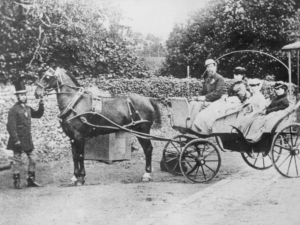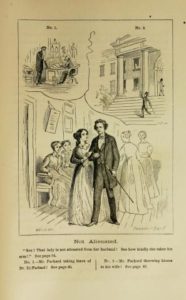
Charles Dickens Tried to Have His Wife Committed to an Asylum During His Affair With a Young Actress, photo circa 1850 of Charles, His Wife, and Two of Their Children, courtesy Smithsonian Magazine
Most families hesitated to commit their loved ones to insane asylums until they became violent, uncontrollable, physically ill, or burdened with conditions that required constant care (hallucinations, suicidal tendencies, etc.). Unfortunately, men sometimes sent the inconvenient women in their lives to asylums, and married women were especially vulnerable.
In 1882, Mrs. Martha J. Collins suspected her husband of infidelity, and when she actually gained proof of it, he retaliated by sending her to the Kings County Lunatic Asylum in NY, and later, to Bloomingdale Asylum. Doctors released her as sane almost immediately from each institution, but her husband pressed on and sent her to the Buffalo State Asylum for the Insane. After five weeks, she managed to get a letter delivered to her legal counsel.

Buffalo State Asylum for the Insane
Mrs. Collins’ attorneys argued that she had been committed illegally, and the asylum’s authorities considered her sane enough to be released into the care of her husband. After discussion (probably rather heated on her part) Judge Smith of the Superior Court released her unconditionally. When her husband approached her, she said, “Mr. Collins, I will shake hands with you: but that is all,” and refused to return home with him unless he agreed not to imprison her again.

A Desperate Elizabeth Packard Tries to Change Her Husband’s Mind About Committing Her to Jacksonville State Hospital in Illinois
Refusing to return home was a courageous step for a woman of that time, who likely had little money of her own or any way of earning a living. She did keep a diary about her asylum experiences, and planned to have it printed. Hopefully, the publicity protected her from any further bullying by her husband.